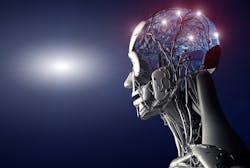Artificial intelligence (AI) in dentistry
If you’re discussing artificial intelligence in dentistry, what is your first thought? It may be, “What is artificial intelligence?” Artificial intelligence, or AI, is the ability of a computer program to learn specific patterns by teaching the program to take actions that mimic human learning and problem-solving capabilities.
Two examples of AI in the dental field are artificial neural networks (ANNs) and convolutional neural networks (CNNs). ANNs are used to find patterns within data and then teach the machine to recognize those patterns.1 CNNs are used for analyzing visual images and image diagnostics. These AI techniques can potentially advance dental care delivery in many ways.
AI can detect dental decay and periodontal disease
Typically, dental caries is detected through a clinical examination of the teeth and the inspection of dental radiographs. While radiograph analysis offers initial objective assessments, tooth morphology, margins of restorations, interproximal contacts, incipient decay, and recurrent decay are often determined by tactile sensation, which can differ among clinicians. Equally important, diagnostic capabilities can vary due to the experience level of the dental provider. AI techniques can be helpful in these scenarios because it’s shown to provide a more efficient diagnostic process when used in conjunction with clinical assessment.
AI can improve quality in the dental field using image detection, classification, and segmentation. For example, CNNs can detect dental decay based on learning the location and morphology of carious lesions on radiographs; thus they’re effective for diagnosing decay.2 There are currently several AI investigational devices on the market that have been approved for use in dentistry. Dental software that can create a set of nodes and connections that accumulate and apply learning by seeing actual data is now available. It works by “emulating the structure and learning process of a human brain.”3 This software uses a cloud-based algorithm and automatically highlights areas of dental decay found on digital radiographs.3 Essentially, it can predict caries by CNN image detection and can be easily integrated into existing workflows.
Additionally, CNN techniques can provide image classification and segmentation that can be used as an additional tool to detect periodontal disease on radiographs. CNNs can capture patterns from periodontally compromised teeth (PCT) images and perform edge detection. “Deep CNN algorithms can automatically learn hierarchical feature representations and capture regional patterns from PCT images in their multiple convolutional and hidden layers.”4 Undoubtedly, using deep CNNs on image datasets will prove to be beneficial in diagnosing and treating periodontal disease with objective accuracy.
AI can detect oral cancer
With regard to dental hygiene appointments, it is important to mention that neural networks are being used to analyze images of oral cancer lesions for early detection and diagnosis. Oral cancer survival rates depend on early diagnosis, and it is imperative that the clinician perform an oral cancer screening at each recall visit. According to Garg and Karjodkar, “If premalignant or potentially malignant lesions are identified early enough, malignant changes may be prevented altogether or at least the chances of success of the treatment at an early stage is more.”5
To assist with early diagnosis, mobile applications have been developed and used for image capture of oral lesions for remote diagnosing.6 Likewise, developments within these applications are being integrated in which deep learning will be used for the system to differentiate between pictures with and without signs of oral cancer.6 In fact, the algorithm will have the ability to classify different oral lesions into one of three categories: benign, malignant, and potentially malignant.7 Theoretically, the use of this type of AI in early detection of oral lesions could provide a higher quality of care as patients could receive the appropriate care at the appropriate time.
Natural language processing used in the operatory
Natural language processing (NLP) is the ability of a computer program to recognize and analyze the human language and process that information to perform tasks. Voice-activated systems are being deployed as add-ons to dental imaging software that can be used for taking digital dental radiographs. Similar to the Amazon Alexa platform, this system uses NLP prompts.8 The clinician tells the system what he or she wants, and the system recognizes the language and carries out the task. The use of NLP to expose digital radiographs allows the clinician to capture the image, as well as view and compare images hands free.8 As a result, voice-activated systems can ultimately improve the dental workflow by optimizing infection control protocols, as well as saving clinicians time and decreasing the patient’s time in the chair.
AI outside of the operatory
AI is also being used for communicating with patients and marketing—from scheduling appointments and analyzing data from patient records, to marketing agendas. Machine-learning programs can interface with dental practice software to track and optimize patient appointments, “to proactively schedule unfinished treatment and launch new-patient marketing campaigns based on profit maximization algorithms.”9 For scheduling, it contacts the patient based on the person’s appointment preference and matches the patient with an available appointment. “Once the ideal patients are identified by proprietary algorithms, the program automates the process of scheduling existing patients with voice, text, or even video and will also initiate the ideal marketing campaign to convert new patients.”10 The neural network can also mine data and find periods of decreased productivity and determine the most effective marketing campaign. This algorithm can monitor available appointments, detect cancellations, track marketing, and use deep learning techniques to search patient records for the most profitable patient treatment.10
Rapid employment of AI in dentistry
Dental providers examine patients for dental decay, periodontal disease, and oral cancer; however, there are several concerns with the accuracy of clinical examination of dental radiographs and the oral exam. To fill the void of inaccuracies, AI techniques can be used to advance the dental field in many ways. Because detection and diagnosis of dental decay and periodontal disease and related treatment can be subjective, the use of AI can potentially standardize dental treatment. As a result, diagnoses can be more accurate and treatment planning can be more precise. Voice-activated systems can improve workflow, and machine-learning algorithms can optimize patient scheduling, treatment plans, and marketing campaigns.
All in all, the use of AI in dentistry can assist dental providers with valuable information that can be used in real time and increase clinicians’ ability to measure the effectiveness of different treatment modalities.11
References
1. Dormehl L. What is an artificial neural network? Here’s everything you need to know. Digital Trends. January 5, 2019. Accessed April 20, 2020. https://www.digitaltrends.com/cool-tech/what-is-an-artificial-neural-network/
2. Lee J-H, Kim D-H, Jeong S-N, Choi S-H. Detection and diagnosis of dental caries using a deep learning-based convolutional neural network algorithm. J Dent. 2018;77:106-111. doi:10.1016/j.jdent.2018.07.015
3. VideaHealth. MIT delta v demo day 2018 Kresge. YouTube. September 10, 2018. Accessed April 20, 2020. https://www.youtube.com/watch?v=uzShTMLXsAc
4. Lee J-H, Kim, D-H, Jeong S-N, Choi S-H. Diagnosis and prediction of periodontally compromised teeth using a deep learning-based convolutional neural network algorithm. J Periodontal Imp Sci. 2018;48(4):114-123. doi 10.5051/jpis.2018.48.2.114
5. Garg P, Karjodkar F. “Catch them before it becomes too late.” Oral cancer detection. Report of two cases and review of diagnostic AIDS in cancer detection. Int J Prev Med. 2012;3(10):737‐741. Accessed April 20, 2020. https://www.ncbi.nlm.nih.gov/pmc/articles/PMC3483004/
6. Park A. Researchers training AI mobile app to detect early signs of oral cancer. Becker’s Health IT. June 5, 2019. Accessed April 18, 2020. https://www.beckershospitalreview.com/artificial-intelligence/researchers-training-ai-mobile-app-to-detect-early-signs-of-oral-cancer.html
7. Barman S, Chan SC, Remagnino P, Cheong SC. Classification of oral lesions using deep learning for early detection of oral cancer. UK Research and Innovation. Updated March 31, 2020. Accessed April 18, 2020. https://gtr.ukri.org/projects?ref=MR%2FS013865%2F1
8. DEXvoice–The smart solution for your dental workflow. Kavo. Accessed April 20, 2020. https://www.kavo.com/en-us/dexvoice-smart-solution-your-dental-workflow
9. Gupta S. The future of artificial intelligence in dentistry. Healthcare in America. August 20, 2018. Accessed May 15, 2020. https://healthcareinamerica.us/the-future-of-artificial-intelligence-in-dentistry-114e04fc4e8f
10. MMG Fusion honored again in 2017 with Cellerant’s best of class technology award. Dental Sleep Practice. September 21, 2017. Accessed April 20, 2020. https://dentalsleeppractice.com/industry-news/mmg-fusionhonored-2017-cellerants-best-class-technology-award/
11. Gupta S. Importance of artificial intelligence in dentistry. DZone. May 8, 2018. Accessed April 20, 2020. https://dzone.com/articles/importance-of-artificial-intelligence-in-dentistry
SHANNON SOMMERS, MSHI, BTDH, RDH, holds a bachelor of technology in dental hygiene from the State University of New York at Canton and a master of science in health informatics from the Medical University of South Carolina. She has more than 20 years of experience in dentistry and has been a dental hygienist since 2006. She strives to use her dental background and informatics skills to influence population health by promoting and advancing the use of dental informatics.
ALICIA WEBB, MSHI, BTDH, RDH, has been a clinician in dentistry since 2006 and has experience as an educator in a dental hygiene program. As one of the few registered dental hygienists to graduate with a master of science in health informatics, she wants to use her informatics knowledge coupled with her dental background to improve population health by developing and analyzing data-driven solutions to improve the delivery of quality dental care.
About the Author

Shannon Sommers, MSHI, BTDH, RDH
SHANNON SOMMERS, MSHI, BTDH, RDH, holds a bachelor of technology in dental hygiene from the State University of New York at Canton and a master of science in health informatics from the Medical University of South Carolina. She has more than 20 years of experience in dentistry and has been a dental hygienist since 2006. She strives to use her dental background and informatics skills to influence population health by promoting and advancing the use of dental informatics.

Alicia Webb, MSHI, BTDH, RDH
ALICIA WEBB, MSHI, BTDH, RDH, has been a clinician in dentistry since 2006 and has experience as an educator in a dental hygiene program. As one of the few registered dental hygienists to graduate with a master of science in health informatics, she wants to use her informatics knowledge coupled with her dental background to improve population health by developing and analyzing data-driven solutions to improve the delivery of quality dental care.
